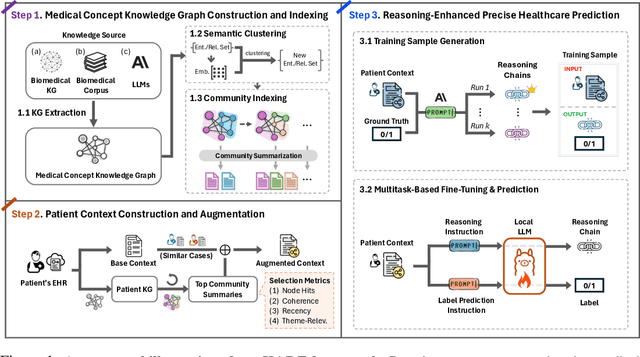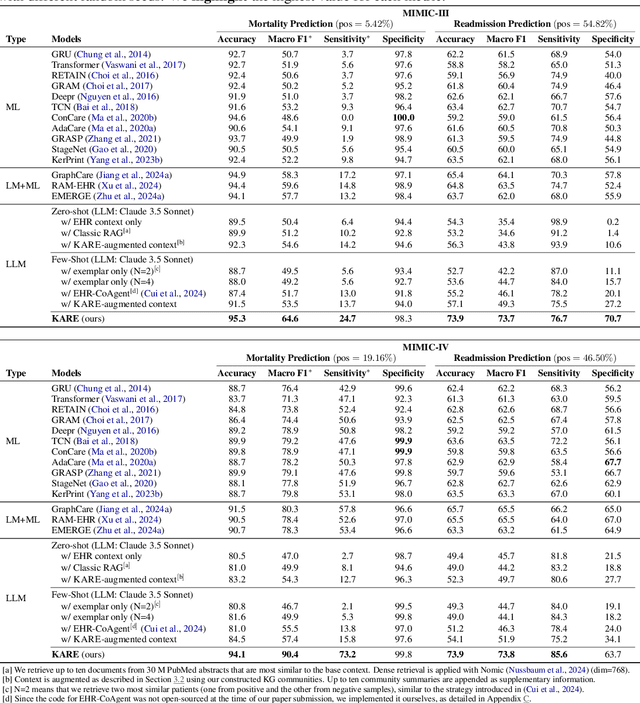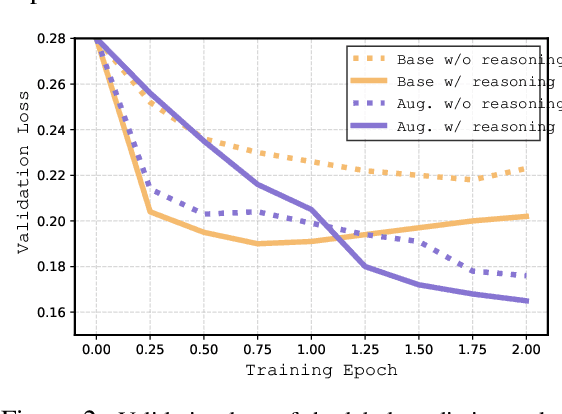Parminder Bhatia
Focus on What Matters: Enhancing Medical Vision-Language Models with Automatic Attention Alignment Tuning
May 24, 2025Abstract:Medical Large Vision-Language Models (Med-LVLMs) often exhibit suboptimal attention distribution on visual inputs, leading to hallucinated or inaccurate outputs. Existing mitigation methods primarily rely on inference-time interventions, which are limited in attention adaptation or require additional supervision. To address this, we propose A$^3$Tune, a novel fine-tuning framework for Automatic Attention Alignment Tuning. A$^3$Tune leverages zero-shot weak labels from SAM, refines them into prompt-aware labels using BioMedCLIP, and then selectively modifies visually-critical attention heads to improve alignment while minimizing interference. Additionally, we introduce a A$^3$MoE module, enabling adaptive parameter selection for attention tuning across diverse prompts and images. Extensive experiments on medical VQA and report generation benchmarks show that A$^3$Tune outperforms state-of-the-art baselines, achieving enhanced attention distributions and performance in Med-LVLMs.
Any Large Language Model Can Be a Reliable Judge: Debiasing with a Reasoning-based Bias Detector
May 21, 2025



Abstract:LLM-as-a-Judge has emerged as a promising tool for automatically evaluating generated outputs, but its reliability is often undermined by potential biases in judgment. Existing efforts to mitigate these biases face key limitations: in-context learning-based methods fail to address rooted biases due to the evaluator's limited capacity for self-reflection, whereas fine-tuning is not applicable to all evaluator types, especially closed-source models. To address this challenge, we introduce the Reasoning-based Bias Detector (RBD), which is a plug-in module that identifies biased evaluations and generates structured reasoning to guide evaluator self-correction. Rather than modifying the evaluator itself, RBD operates externally and engages in an iterative process of bias detection and feedback-driven revision. To support its development, we design a complete pipeline consisting of biased dataset construction, supervision collection, distilled reasoning-based fine-tuning of RBD, and integration with LLM evaluators. We fine-tune four sizes of RBD models, ranging from 1.5B to 14B, and observe consistent performance improvements across all scales. Experimental results on 4 bias types--verbosity, position, bandwagon, and sentiment--evaluated using 8 LLM evaluators demonstrate RBD's strong effectiveness. For example, the RBD-8B model improves evaluation accuracy by an average of 18.5% and consistency by 10.9%, and surpasses prompting-based baselines and fine-tuned judges by 12.8% and 17.2%, respectively. These results highlight RBD's effectiveness and scalability. Additional experiments further demonstrate its strong generalization across biases and domains, as well as its efficiency.
Enhancing SAM with Efficient Prompting and Preference Optimization for Semi-supervised Medical Image Segmentation
Mar 06, 2025Abstract:Foundational models such as the Segment Anything Model (SAM) are gaining traction in medical imaging segmentation, supporting multiple downstream tasks. However, such models are supervised in nature, still relying on large annotated datasets or prompts supplied by experts. Conventional techniques such as active learning to alleviate such limitations are limited in scope and still necessitate continuous human involvement and complex domain knowledge for label refinement or establishing reward ground truth. To address these challenges, we propose an enhanced Segment Anything Model (SAM) framework that utilizes annotation-efficient prompts generated in a fully unsupervised fashion, while still capturing essential semantic, location, and shape information through contrastive language-image pretraining and visual question answering. We adopt the direct preference optimization technique to design an optimal policy that enables the model to generate high-fidelity segmentations with simple ratings or rankings provided by a virtual annotator simulating the human annotation process. State-of-the-art performance of our framework in tasks such as lung segmentation, breast tumor segmentation, and organ segmentation across various modalities, including X-ray, ultrasound, and abdominal CT, justifies its effectiveness in low-annotation data scenarios.
MedHEval: Benchmarking Hallucinations and Mitigation Strategies in Medical Large Vision-Language Models
Mar 04, 2025Abstract:Large Vision Language Models (LVLMs) are becoming increasingly important in the medical domain, yet Medical LVLMs (Med-LVLMs) frequently generate hallucinations due to limited expertise and the complexity of medical applications. Existing benchmarks fail to effectively evaluate hallucinations based on their underlying causes and lack assessments of mitigation strategies. To address this gap, we introduce MedHEval, a novel benchmark that systematically evaluates hallucinations and mitigation strategies in Med-LVLMs by categorizing them into three underlying causes: visual misinterpretation, knowledge deficiency, and context misalignment. We construct a diverse set of close- and open-ended medical VQA datasets with comprehensive evaluation metrics to assess these hallucination types. We conduct extensive experiments across 11 popular (Med)-LVLMs and evaluate 7 state-of-the-art hallucination mitigation techniques. Results reveal that Med-LVLMs struggle with hallucinations arising from different causes while existing mitigation methods show limited effectiveness, especially for knowledge- and context-based errors. These findings underscore the need for improved alignment training and specialized mitigation strategies to enhance Med-LVLMs' reliability. MedHEval establishes a standardized framework for evaluating and mitigating medical hallucinations, guiding the development of more trustworthy Med-LVLMs.
Deep Linear Hawkes Processes
Dec 27, 2024Abstract:Marked temporal point processes (MTPPs) are used to model sequences of different types of events with irregular arrival times, with broad applications ranging from healthcare and social networks to finance. We address shortcomings in existing point process models by drawing connections between modern deep state-space models (SSMs) and linear Hawkes processes (LHPs), culminating in an MTPP that we call the deep linear Hawkes process (DLHP). The DLHP modifies the linear differential equations in deep SSMs to be stochastic jump differential equations, akin to LHPs. After discretizing, the resulting recurrence can be implemented efficiently using a parallel scan. This brings parallelism and linear scaling to MTPP models. This contrasts with attention-based MTPPs, which scale quadratically, and RNN-based MTPPs, which do not parallelize across the sequence length. We show empirically that DLHPs match or outperform existing models across a broad range of metrics on eight real-world datasets. Our proposed DLHP model is the first instance of the unique architectural capabilities of SSMs being leveraged to construct a new class of MTPP models.
Dynamic Uncertainty Ranking: Enhancing In-Context Learning for Long-Tail Knowledge in LLMs
Oct 31, 2024Abstract:Large language models (LLMs) can learn vast amounts of knowledge from diverse domains during pre-training. However, long-tail knowledge from specialized domains is often scarce and underrepresented, rarely appearing in the models' memorization. Prior work has shown that in-context learning (ICL) with retriever augmentation can help LLMs better capture long-tail knowledge, reducing their reliance on pre-trained data. Despite these advances, we observe that LLM predictions for long-tail questions remain uncertain to variations in retrieved samples. To take advantage of the uncertainty in ICL for guiding LLM predictions toward correct answers on long-tail samples, we propose a reinforcement learning-based dynamic uncertainty ranking method for ICL that accounts for the varying impact of each retrieved sample on LLM predictions. Our approach prioritizes more informative and stable samples while demoting misleading ones, updating rankings based on the feedback from the LLM w.r.t. each retrieved sample. To enhance training efficiency and reduce query costs, we introduce a learnable dynamic ranking threshold, adjusted when the model encounters negative prediction shifts. Experimental results on various question-answering datasets from different domains show that our method outperforms the best baseline by $2.76\%$, with a notable $5.96\%$ boost in accuracy on long-tail questions that elude zero-shot inference.
Reasoning-Enhanced Healthcare Predictions with Knowledge Graph Community Retrieval
Oct 06, 2024



Abstract:Large language models (LLMs) have demonstrated significant potential in clinical decision support. Yet LLMs still suffer from hallucinations and lack fine-grained contextual medical knowledge, limiting their high-stake healthcare applications such as clinical diagnosis. Traditional retrieval-augmented generation (RAG) methods attempt to address these limitations but frequently retrieve sparse or irrelevant information, undermining prediction accuracy. We introduce KARE, a novel framework that integrates knowledge graph (KG) community-level retrieval with LLM reasoning to enhance healthcare predictions. KARE constructs a comprehensive multi-source KG by integrating biomedical databases, clinical literature, and LLM-generated insights, and organizes it using hierarchical graph community detection and summarization for precise and contextually relevant information retrieval. Our key innovations include: (1) a dense medical knowledge structuring approach enabling accurate retrieval of relevant information; (2) a dynamic knowledge retrieval mechanism that enriches patient contexts with focused, multi-faceted medical insights; and (3) a reasoning-enhanced prediction framework that leverages these enriched contexts to produce both accurate and interpretable clinical predictions. Extensive experiments demonstrate that KARE outperforms leading models by up to 10.8-15.0% on MIMIC-III and 12.6-12.7% on MIMIC-IV for mortality and readmission predictions. In addition to its impressive prediction accuracy, our framework leverages the reasoning capabilities of LLMs, enhancing the trustworthiness of clinical predictions.
BIPEFT: Budget-Guided Iterative Search for Parameter Efficient Fine-Tuning of Large Pretrained Language Models
Oct 04, 2024



Abstract:Parameter Efficient Fine-Tuning (PEFT) offers an efficient solution for fine-tuning large pretrained language models for downstream tasks. However, most PEFT strategies are manually designed, often resulting in suboptimal performance. Recent automatic PEFT approaches aim to address this but face challenges such as search space entanglement, inefficiency, and lack of integration between parameter budgets and search processes. To overcome these issues, we introduce a novel Budget-guided Iterative search strategy for automatic PEFT (BIPEFT), significantly enhancing search efficiency. BIPEFT employs a new iterative search strategy to disentangle the binary module and rank dimension search spaces. Additionally, we design early selection strategies based on parameter budgets, accelerating the learning process by gradually removing unimportant modules and fixing rank dimensions. Extensive experiments on public benchmarks demonstrate the superior performance of BIPEFT in achieving efficient and effective PEFT for downstream tasks with a low parameter budget.
Enhancing Visual-Language Modality Alignment in Large Vision Language Models via Self-Improvement
May 29, 2024



Abstract:Large vision-language models (LVLMs) have achieved impressive results in various visual question-answering and reasoning tasks through vision instruction tuning on specific datasets. However, there is still significant room for improvement in the alignment between visual and language modalities. Previous methods to enhance this alignment typically require external models or data, heavily depending on their capabilities and quality, which inevitably sets an upper bound on performance. In this paper, we propose SIMA, a framework that enhances visual and language modality alignment through self-improvement, eliminating the needs for external models or data. SIMA leverages prompts from existing vision instruction tuning datasets to self-generate responses and employs an in-context self-critic mechanism to select response pairs for preference tuning. The key innovation is the introduction of three vision metrics during the in-context self-critic process, which can guide the LVLM in selecting responses that enhance image comprehension. Through experiments across 14 hallucination and comprehensive benchmarks, we demonstrate that SIMA not only improves model performance across all benchmarks but also achieves superior modality alignment, outperforming previous approaches.
KG-FIT: Knowledge Graph Fine-Tuning Upon Open-World Knowledge
May 26, 2024



Abstract:Knowledge Graph Embedding (KGE) techniques are crucial in learning compact representations of entities and relations within a knowledge graph, facilitating efficient reasoning and knowledge discovery. While existing methods typically focus either on training KGE models solely based on graph structure or fine-tuning pre-trained language models with classification data in KG, KG-FIT leverages LLM-guided refinement to construct a semantically coherent hierarchical structure of entity clusters. By incorporating this hierarchical knowledge along with textual information during the fine-tuning process, KG-FIT effectively captures both global semantics from the LLM and local semantics from the KG. Extensive experiments on the benchmark datasets FB15K-237, YAGO3-10, and PrimeKG demonstrate the superiority of KG-FIT over state-of-the-art pre-trained language model-based methods, achieving improvements of 14.4%, 13.5%, and 11.9% in the Hits@10 metric for the link prediction task, respectively. Furthermore, KG-FIT yields substantial performance gains of 12.6%, 6.7%, and 17.7% compared to the structure-based base models upon which it is built. These results highlight the effectiveness of KG-FIT in incorporating open-world knowledge from LLMs to significantly enhance the expressiveness and informativeness of KG embeddings.
 Add to Chrome
Add to Chrome Add to Firefox
Add to Firefox Add to Edge
Add to Edge